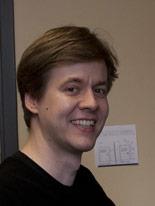In a groundbreaking discovery that was named 2013 Breakthrough of the Year by Physics World magazine, the IceCube Neutrino Observatory in Antarctica reported the first solid evidence of high-energy astrophysical neutrinos from outside the solar system.
 More than 250 scientists from around the globe are contributors to the IceCube collaboration, including University of Alberta physics professor Claudio Kopper. Kopper was recently awarded the 2015 Young Scientist Prize in Astroparticle Physics from the International Union of Pure and Applied Physics (IUPAP) for his outstanding contribution to the analysis of the IceCube Neutrino-Telescope data.
More than 250 scientists from around the globe are contributors to the IceCube collaboration, including University of Alberta physics professor Claudio Kopper. Kopper was recently awarded the 2015 Young Scientist Prize in Astroparticle Physics from the International Union of Pure and Applied Physics (IUPAP) for his outstanding contribution to the analysis of the IceCube Neutrino-Telescope data.
The award recognizes young scientists who have made outstanding contributions to the area of Astroparticle Physics, and is limited to those with fewer than eight years of research experience following the receipt of their PhD.
"I feel very honored to receive the IUPAP Young Scientist Prize in Astroparticle Physics," says Kopper. "It has been an exciting road up to this point, and I hope that this recognition will help to demonstrate neutrino astro-particle physics is an exciting field. We have exciting times ahead of us."
Kopper's first foray into neutrino detectors was during his PhD in Germany, when worked on designs for the KM3NeT neutrino telescope, currently being built in the Mediterranean Sea. There, he was responsible for much of the simulation and optimization work for one of the possible detector technologies, now being deployed during the initial construction of the detector. For a short time, he continued this work in preparation for the experiment's technical design report at the Dutch National Institute for Subatomic Physics in Amsterdam before joining the IceCube group at its University of Wisconsin headquarters.
"My main achievement while working on IceCube was, of course, the discovery of a high-energy flux of astrophysical neutrinos," he notes, referencing the 2013 discovery. "The flux had been hypothesized and was the main reason the detector was built. Until this discovery, it was unknown at which level this flux existed and uncertain if our detector could unambiguously detect it."
Kopper is now a professor in the Department of Physics, joining additional UAlberta IceCube collaborator Darren Grant. "One of the most important parts of getting to where I am now has always been working with a team of outstanding people," says Kopper. "My work is with data collected by the IceCube Neutrino Observatory at the South Pole, built by an international team from all over the world, including major groups in the US, Germany, Sweden and, of course, Canada."
Moving forward, Kopper plans to continue his work in describing the properties of the astrophysical neutrino flux as well as locate its sources. "so far we have only been able to detect it as a "diffuse" flux over the whole sky without the ability to point conclusively to its sources on the sky," he explains. "With future analyses, we want to find where on the sky these sources are in order to see what we can learn from them about particle physics."
Kopper will be formally presented with the Young Scientist Award on July 30, the opening day of the International Cosmic Ray Conference (ICRC) in the Hague, Netherlands, at which he will be presenting a review talk on recent results in neutrino astronomy.